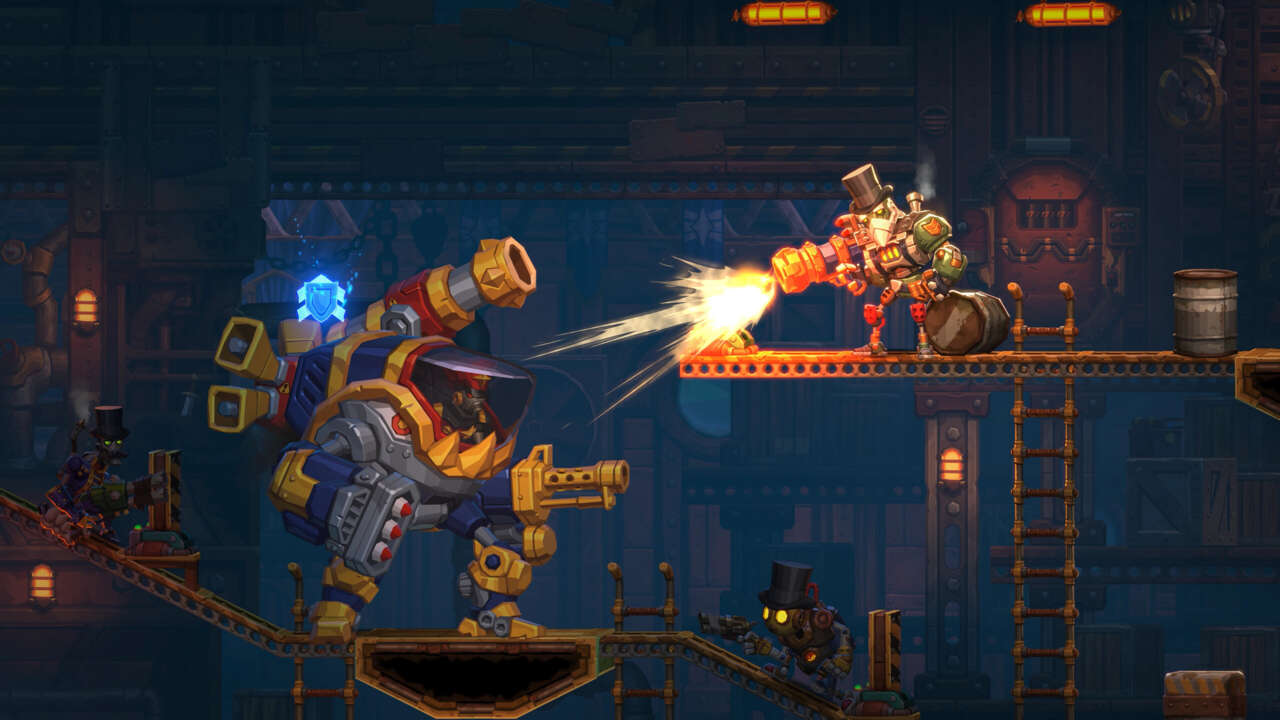SteamWorld Heist 2 marks the seventh game in the SteamWorld franchise, which has built itself more as an anthology than a series. The name is a playground for different ideas, loosely connected around a cartoon-robot aesthetic, rather than a connected universe of familiar gameplay structures and stories. Heist 2 marks only the second direct sequel, after SteamWorld Dig 2. Since Dig was SteamWorld’s breakthrough, it seems significant that the second true sequel is going to the more-modest cult-hit SteamWorld Heist. But the proof is in the pudding, as SteamWorld Heist 2 is a massive leap over the first game, expanding on virtually all of its systems without overcomplicating them or compromising its charm.
Like the first game, SteamWorld Heist 2 defies easy categorization, as it really only plays like itself. You and your band of Steambots go on missions to tightly enclosed indoor spaces, and take part in turn-based tactical combat. While there is cover and abilities with cooldowns like you might find in a typical XCOM-like, the 2D perspective shifts more than just your point-of-view–in comparison to its genre contemporaries, Heist 2 plays extremely differently. Rather than flanking around enemies, there’s a huge emphasis on verticality, as well as lining up trick-shots using laser sight-like aimlines to bounce your projectiles off the walls or objects to hit an enemy ducking behind cover. And like the first game, you can pick up bags of optional loot, typically including one especially well-hidden or well-guarded piece of epic loot, and then head for the evacuation point to end the mission. How long you stay to grab every last piece of loot is often pressed by an escalating alarm system, creating a nice tension between risk and reward.
Where SteamWorld Heist 2 builds on the first game’s structure is through a variety of new systems, each of which feels full-fledged in itself and complements the existing loop. Primary among these is a new job-class system, which is defined by your weaponry. Any Steambot can equip any job by simply switching their primary weapon during the mission loadout, and the requisite experience points they earn in that mission will go toward the equipped job. Each job has five levels to unlock, with a sequence of powerful abilities becoming available throughout.
The real fun is in mixing and matching the abilities you’ve already mastered to unlock new combinations that can feel gloriously overpowered. The Reaper, for example, is usually restricted to SMGs, which have a shorter aimline than most other jobs. But you can master its Harvest skill, which lets you continue to take shots at enemies as long as you’re delivering fatal damage, and then equip it onto a stronger class like Boomer or a long-range class like Sniper, allowing one unit to potentially clear a whole room. Similarly, you can take the Flanker, a shotgun-wielding class that’s especially mobile, and apply its abilities to a Sniper to give them access to better vantage points. Or you can take a Sniper’s detailed aim-sight and give it to a Boomer to see where their rockets’ splash damage will hit. Toying with these combinations is a real treat, and vital for mastering some of the late-game challenges.
One point I especially loved about the job system is how it handles excess experience points. Typically in a game with job classes, mastering a job presents you with an annoying choice: Stick with your mastered job to give you the best shot at completing difficult story missions but gain no experience, or switch to another job to gain experience but become much weaker as a result. This softly pushes players toward going back and grinding with other jobs, which isn’t terribly fun. In SteamWorld Heist 2, however, you can keep your mastered jobs equipped, and excess experience points earned go into that character’s reserve pool. The pool is then automatically applied to the next job you equip and complete a mission with. So you can keep your elite-level Sniper for critical story missions, and bank the experience you earn along the way, then switch to another job for an older and easier mission to apply all that banked experience and catch up with a different job. This is a brilliant solution to a common design problem, and it sands off a major rough edge of most job-class systems.
Your capacity to equip extra abilities is determined by your Cogs–slots for non-primary abilities. You’ll have a certain amount of Cogs by default, but this also plays into other systems. Certain equipment will give you more Cog slots if you want to cook up some wicked combinations, or they can be used for other utilities like enhanced armor, sidearms or grenades, or healing packs. And even within a single job, the weapon variety is expansive–one SMG might offer more burst-fire but won’t ricochet off walls, while another may offer armor-piercing or healing properties. It’s incredibly flexible and lets you build out your team to suit your playstyle.
Aside from upgrading your individual crew members with jobs and equipment, you’ll also earn special currency to spend in your home base, which will go toward advancing your party in other ways. You can choose to spend it on individual, unique abilities for each of your party members, or job-class upgrades that will be applied to any bot equipped with that job. My MVP was Daisy, whose ultimate unique ability reduces the Cog cost of all abilities, making her the ideal tester for different job combinations.
You can also use that currency to enhance the submarine, your floating home base that is also your roving battle station. As opposed to the first game, Heist 2 all takes place on a single planet almost entirely covered in water. Your submarine will transport you to missions, but it will also take part in exciting real-time naval battles against enemy ships, or can be used to explore and find hidden nooks with their own special caches of equipment. As you unlock more submarine equipment slots, it becomes almost as customizable as your characters, letting you determine which types of weapons to use, whether you want to prioritize speed or strength, and so on. The submarine combat feels like a minigame but it’s nicely fleshed out and a good change of pace from the regular mission combat.
The water-logged planet is also a major element in the story. The water supply–the lifeblood of steam-powered robots–is getting corrupted and leading to a condition known as the Rust. The dominant factions are the high-powered and shiny Dieselbot Navy, who pride themselves on not needing steam power, and the Rattlers, a grim robot cult whose members have started systematically replacing their metal parts with bones, which don’t rust.
The main protagonist is Captain Quincy Leeway, a one-armed Steambot living in the shadow of his mother, a legendary captain herself. Most of the story revolves around Leeway learning how to forge his own path under the weight of those expectations, but he’s also not an active participant in missions. Instead, he’s the voice in the earpiece of your other mission-bound bots, giving instructions and providing context for the missions. You do play as Leeway when exploring your ship or docking with a store, or solving the occasional simple exploration puzzle. And while Leeway starts out simply looking for a score, it’s not long before the story turns toward uncovering the secret of the Rust corruption, as well as getting caught between the warring factions. This is ultimately a tale about a ragtag group of ne’er-do-well pirates who become a family, and while it can be a little dialogue-heavy in rare moments, it’s in service of a sweet story.

As you progress through the world and uncover the map–with an ever-so-satisfying cloud-clearing animation as you do–you’ll find certain areas ability-locked for your submarine. That gating comes down to yet another system: your local reputation. To earn a specific new piece of submarine equipment, you’ll often need to accrue a certain level of reputation by completing missions in the area. Usually this means either perfecting a few missions, or merely completing several of them. Your reputation can be cashed in for special “bounty” rewards when you rest at an inn. Resting is the only way to regain access to party members you’ve already used, so maximizing your reputation and bounty rewards means having a deep bench of robots to complete multiple missions between each stay at the inn. It’s just one more way Heist 2 smartly pushes you toward maximizing your efficiency with another tactical wrinkle.
What’s most impressive about all of these disparate systems is how well they synergize with each other, and how they remain easily understandable and not overwhelming. Like a well-crafted Steambot, each part and gear of SteamWorld Heist 2 attaches just-so to another, with every piece of the device contributing and feeding into the function of two or three other parts. The result is a game that plays with clockwork precision from start to finish.






